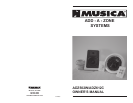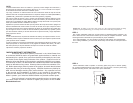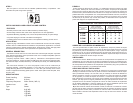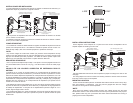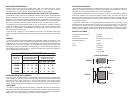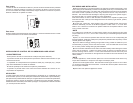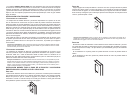
MUSICA ADD-A-ZONE systems are designed for ease of installation in both new
construction and existing structures. The typical In-wall/ In-ceiling speaker system and
accessories mounting technique is not difficult, and is well within the ability of the a
verage
do-it-yourself. Proper preparations are required beforehand, and vary greatly depending
on the building.
INSTALLING SPEAKERS AND ACCESSORIES
New Construction
The obvious advantage of installing In-wall / In-ceiling speakers and accessories during
new construction is that you are able to pre-wire to desired mounting locations. Once
framing is complete, decide roughly where your speakers/accessories are to be mounted,
and where the audio equipment will be located. Next, run the wire provided from the audio
equipment location to the stud bay where speakers will be mounted. When running A/V
wire or cable, it is recommended that you drill new holes for your wire, and not use ex
isting
power cable holes, as this may cause interference problems. It is also against building
codes in many areas.
Let a length of speaker lead hang freely in each stud bay. A stud bay is the term used by
contractors to describe the area between any two wall studs.
Installers Tip - Draw a diagram of the room and indicate the distance from the wires to the nearest
reference wall. This can make finding your cables much easier when you are ready to install the
actual speaker.
Old Construction
Installing a In-wall / In-ceiling speaker system and accessories can be a fairly simple task,
or can be somewhat involved depending on the building. For instance, if you want to run
a A/V cable or speaker leads from the basement to a second floor bedroom, pulling your
cable can require a great deal of patience, but will become less complicated for the average
do-it-yourselfer with each wire pulled!
Installers Note - If the structure is less than 50 years old, then walls are most likely made of
gypsum-based wallboard. This will be fairly easy to cut using a drill and keyhole saw or rotary cutter.
If your home is older, you may encounter plaster and lathe type walls construction. Cutting this type
or material can be tricky, and will require extra care as it is sometimes dry and bri
ttle.
STEP-BY-STEP TYPICAL IN-WALL / IN-CEILING INSTALLATION
STEP 1
Determine the location for your new speakers and accessories. Use a stud finder or
other reliable method to locate studs. Using the templates provided, trace hole positions
on surface of wall. Placing a bubble level on either the horizontal or vertical guidelines
of
template will assist you in leveling the hole pattern.
STEP 2
Cut the speaker/accessory mounting hole. Once you have located the wall studs, use
the supplied mounting template to trace the cutout hole. Before you actually cut the hole,
it is best to double-check all measurements. This helps to insure you won't be fixing any
NOTES



